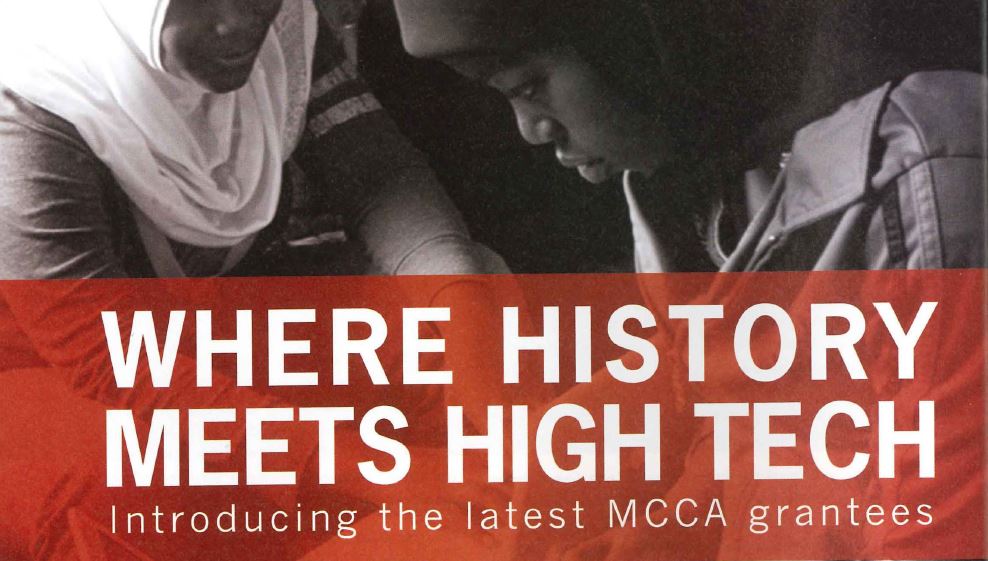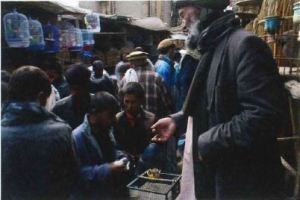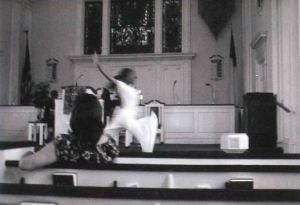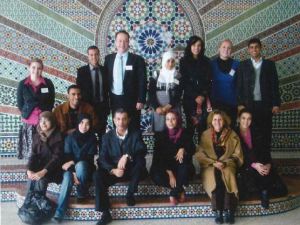
This article originally appeared in the May/June 2010 edition of the Museum magazine.
Introducing the latest MCCA grantees
When representatives of two cultures are able to compare notes on their art, their histories, the struggles they share and the dreams they hold, magic can happen.
AAM’s Museums and Community Collaborations Abroad (MCCA) program lays the foundation for this kind of team work, using technology to wipe away geographic boundaries and time differences. Through a unique partnership between AAM and the U.S. Department of State’s Bureau of Educational and Cultural Affairs, MCCA grants help communities within and outside of the United States to develop an understanding of another culture through projects facilitated by one or more museums.
The grants also seek to support museums as they build models for international collaboration that not only reach beyond physical boundaries but can be replicated by other institutions for their own benefit. Here, we outline the aims of recent grantees.
Not Just Another Brick in the Wall: Engaging Italian and American Teens
Partners: Sci-Port: Louisiana’s Science Center, Shreveport, and Parco Astronomico InfiniTo, Pino Torinese, Italy
Like teens everywhere, young people in Turin, Italy, and Shreveport, La., have stars in their eyes. One particular gaggle of kids from these cities, however, is looking skyward for inspiration for an original rock opera that will be shown in planetariums in each of their countries: the Planetaria di Torino, part of the Parco Astronomico InfinitTo, and the Space Dome planetarium at Sci-Port.
The teenagers are using a multi-disciplinary approach to create a 25-minute production themed around a day in the life of a typical high school student. As each team contributed six scenes to the finished product, the teens developed skills ranging from software programming to writing to making scientific observations. And, of course, there’s the ongoing cultural exchange as they collaborate online, learning about science, project management and one another.
Sci-Port is “really interested in engaging a teen audience,” says Rebecca Prosino, director of marketing and strategic projects. “A lot of our exhibits are very high-level. [even] challenging for adults. This project is one way to bridge the audience between young children and parents.” An equally important goal is building a project with the potential to boost participants’ science, math and technology skills, she says.
The two dozen participants are creating content online so each group can better track the other’s work. Social media tools like Facebook make it easy to post video snippets, ask questions about different aspects of the project and solicit earnest feedback on chunks of footage. English is the group’s primary language, but the Americans have practiced nascent Italian-speaking skills.
Technology is a potent ally in encouraging everyone to invest more of themselves.
Technology is a potent ally in terms of encouraging everyone involved to invest more of themselves in the project. For example, the Internet phone service Skype permits regular real-time phone conversations that help break the ice, while ongoing blog updates among the students and their advisers are designed to help cement ties. In recent posts to the group, Prosino has encouraged the teens to think about the project in a more holistic way-less “ours” and “theirs,” more “all of ours.”
In-person contact took place at the conclusion of the project, Prosino says. Sci-Port planned a red-carpet event for the premiere of the show in April, with the Italian teens in attendance. In May, the Americans will travel to Italy for the debut of the project at the planetarium in Turin.
Carrying Traditions Across the Waters of Time: Ainu and Pacific Northwest Cultural Collaborations
Partners: Burke Museum of Natural History and Culture, Seattle, and Hokkaido Ainu Center, Sapporo, Japan
From a common heritage of building canoes, native peoples from coastal communities of Hokkaido, Japan’s second-largest island, and the American Pacific Northwest are forging ties. In partnership with the Hokkaido Ainu Center, the Burke-part of the University of Washington (UW)-is providing a place for tribal groups to share and discuss myriad cultural and political issues, says Deana Dartt-Newton, curator of Native American ethnology. Despite language barriers, members of both groups are mining a common lode of shared cultural, political and other experiences.
An assistant professor of American Indian studies at UW, Dartt-Newton arranged for about a dozen visiting Ainu to spend time with members of six Puget Sound-area tribal groups, as well as with an intertribal organization. During their stay in December, the groups visited the Burke, several reservations, and the Seattle Art Museum, where they viewed historic kimonos from the collections. While there, the Ainu provided the museum’s textile experts with much-needed information about the garments’ fabric and construction.
Dartt-Newton, a member of the Chumash tribe, described how people-including members of the Pacific Northwest Makah, Suquamish, Squaxin Island, Tulalip, and Duwamish tribes-connected during the Ainu visit. “There were political discussions about rights, from hunting rights to resource rights, and what sovereignty has meant to all the participating tribes,” she says. Such dialogue was very important to the Ainu, who only recently received federal recognition from the government of Japan, she notes. (In June 2008, Japan’s parliament adopted a resolution to formally recognize the indigenous people’s language, religion, and culture.)
In addition to politics, methods of sharing and teaching traditional arts-from weaving to salmon fishing-were discussed, as were efforts to revitalize the teaching of native languages and other threatened cultural practices. “Interwoven throughout the week was the familiarity of sharing the pain of [cultural] loss due to colonization,” says Dartt-Newton. “It gave a real intimacy to the rest of the conversations.” And yet the connections the indigenous peoples felt with one another overshadowed the grief, she adds. “The sense of pride and excitement about cultural knowledge was contagious.”
Representatives from the participating tribal groups accompanied Dartt-Newton, students in the Native Voices film program at UW and others when they visited Hokkaido in March. The next meeting will likely occur when some of the Ainu return stateside this summer to take part in Tribal Journey 2010, during which representatives of tribes from around the globe will paddle 100-plus native canoes in Washington’s Neah Bay.
“Museums like the Burke have a certain responsibility to indigenous communities to provide a place for these exchanges,” Dartt-Newton says, adding that the discussion made possible by the MCCA grant “has enriched both sides in ways I could not have imagined.”
We, the People: Afghanistan, America & the Minority Imprint
Partners: National Constitution Center, Philadelphia, and the National Museum of Afghanistan, Kabul


Step one: Give digital cameras to 20-odd Afghan and American teenagers. Step two: Ask them to document in photos the people, places, and things that make them think of freedom, dissent and independence. Step three: Observe cross-cultural friendships taking root as the teens discuss through the medium of photography what freedom means to them.
When the National Constitution Center (NCC) joined forces with the National Museum of Afghanistan, as well as Kabul and Philadelphia high schools, the organizations embraced a common cause: helping kids whose native countries have a complex political relationship (including an ongoing war) learn from one another while exploring concepts like democracy and liberty.
The students’ photographs are visible online at Shutterfly; later this year, about 300 selections will be exhibited at NCC.
The content has varied depending on current events. Aziz Royesh, a civic education teacher at Kabul’s Marefat High School and a project adviser, said in an e-mail that allegations of fraud in Afghanistan’s 2009 election prompted challenging discussions among the 10 Afghan participants in the project. They and their American counterparts tried to relate their theories of democracy with the realities of the two countries, he says, noting that the two don’t always match up. “Freedom is something granted to the American kids, while our students have to struggle for it,” he said.
On each side, the students explained the inspiration for their photos and, when possible, responded to an image generated by a teen in the other country by sending a similar one of their own. David Eisner, president and CEO of NCC, describes an American photo of a Philadelphia street vendor selling baked goods that was particularly striking to the Afghan students. “It says something about the vendor’s individuality and his being able to do this kind of work. The Afghan students said how amazing it was that you can just have a food cart like that, and they said that they wished people were allowed to open that kind of bakery in Afghanistan.”
The Afghan students are expected to travel to Philadelphia this summer. Given the war, a visit to Afghanistan by the American students, who attend Philadelphia’s Constitution High School (sponsored in part by NCC), is uncertain.
Both groups captured images related to their countries’ recent elections: Afghanistan in 2009, the U.S. in 2008. “There is real reverence for the principle of democracy,” Eisner says of those photos. “The American and Afghan students are learning together and thinking about pressing issues that affect each other.”
Water: Using the Common Tie That Binds
Partners: Rodger Ehnstrom Nature Center, Wahpeton, N.Dak., Bendery City tv1useum of Ethnography & Natural History, Moldova, River Keepers of the Red River Valley, Fargo, N.Dak., and Eco-Tiras, Moldova
It takes a lot of people to do right by a river, says Bob Backman, executive director of River Keepers of the Red River Valley. Backman’s organization and the Rodger Enhstrom Nature Center (RENC) have been working with the City Museum of Ethnography and Natural History in Moldova, a southeastern European country. Using MCCA funds, the groups seek solutions to water-conservation problems and aim to improve the health of the Red River and the Dniester River.
Though the world’s rivers and oceans are intrinsically connected, the health of oceans seems to get more attention from concerned citizens. “In the past, people here and in Moldova have tended to ignore the rivers,” says Christine Laney, project coordinator for River Keepers. However, recent catastrophic flooding affecting several states and countries, as well as sanitation and environmental issues, revealed how rivers’ poor health may imperil our own lives.
Backman’s organization has had a long relationship with the nature center, part of the Chahinkapa Zoo. In May, the North Dakota group will welcome the Moldovan delegation, treating them to a barbecue, a visit to the zoo and other events. The U.S. delegation is slated to visit Moldova in July.
“We may not use guns to fight over water, but people have serious differences in the way in which we regard water usage,” says Backman. One state or country, for example, may drain or divert rivers so water is channeled where it is needed most. Yet an adjacent state or country might view this as an act of war. With sources of fresh water becoming scarcer, discussing the intersection of politics, the environment and human health is critical.
“Through social networking, this project can reach millions of interested people, young and old.”
Kathy Dieker is director of the Chahinkapa Zoo and RENC, which host workshops, classes and conservation programs year-round. “Through social networking, this project can reach millions of interested people, young and old,” she says. And, through freestanding exhibits slated for each museum, the public can learn more about river politics and geology.
Before the nature center and the Moldovan museum received the MCCA grant, Backman had visited Moldova to discuss the Dniester’s problems and policies and make contact with Eco-Tiras, a nonprofit based in Moldova that connects organizations working for better river health. Geography, time zones, and politics aside, “we’re discovering we can learn a lot from each other,” he says.
The mutual learning will continue in more ways than one. A group that includes zookeepers from the Chahinkapa Zoo and North Dakota college students has stepped former school in Moldova, where a Moldovan Youth Water Festival is being planned.

Creating Community Collaboration
Partners: Museum of History and Holocaust Education, Kennesaw, Ga., and Ben M’sik Community Museum, Casablanca, Morocco
From cultural, religious and historical perspectives, a shared Muslim and American identity is the subject of “Creating Community Collaboration,” an ongoing project that examines Muslim stereotypes and compares Muslim life in two very different cultures.
Through the project, Muslim citizens of Georgia are learning what it means to be Muslim in Morocco, says Catherine Lewis, an associate professor of history at Kennesaw State University (KSU) and director of its Museum of History and Holocaust Education (MHHE).
At the same time, Moroccan Muslims, through a series of virtual and face-to-face discussions, are gaining insight into Muslim-American life, particularly in the American South. By reaching into their respective local communities, the MHHE and the Ben M’sik Community Museum are collecting oral histories that will generate a rich record of 21st-century social, religious and family experiences for Muslims in two countries.
Prior to the MCCA grant, the organizations had been working together for two years, producing a collaborative exhibition in English and Arabic, Lewis says. In 2007 and 2008, each group visited the other’s museums and universities to discuss how to grow the partnership. More visits have taken place since the grant was made, fortifying trust and making even difficult topics-such as Muslim extremism and Sept. 11-a bit easier to broach, Lewis says.
“I have taken oral histories for years, and it takes a long time to get to the truth,” Lewis says, noting that trust is essential. “We know their families and they know ours. We have been in each other’s homes.” While social media and other such technologies as video conferencing and Skype help, “there is nothing like being there.”
In December, a group of KSU students and faculty spent a week in Casablanca. Moroccan and American college students talked openly and honestly with one another, challenging cultural perceptions and sharing experiences from each other’s lives.
Many of the Moroccan students in the project are from Ben M’sik, a working-class community in Casablanca with
nearly a half-million inhabitants. It’s in that very neighborhood that a community-based museum has opened, with the help of the MHHE delegation.
“Our purpose is not to replicate our museum in Morocco,” Lewis says. Rather, she says the groups’ shared interest in museum studies-and the ongoing collection of that oral histories create a framework for exploring Muslim and American culture here and abroad.
What’s next? Everything from a theater piece and other public programs to more exhibitions says Lewis, predicting the project could last 10 to 15 years more, far longer than the duration of the grant period. “The MCCA grant has strengthened this partnership. It has provided us a wonderful springboard from which to continue to grow.”
The words of students who have traveled to Morocco are a powerful testament to the lasting impact of the project.
“While I consider myself an open and accepting person, this trip has allowed me to explore some of my perceptions of Islam face to face,” wrote Stefanie Green, a KSU student. “I don’t think I will ever be able to express how grateful I have been for this experience.”







